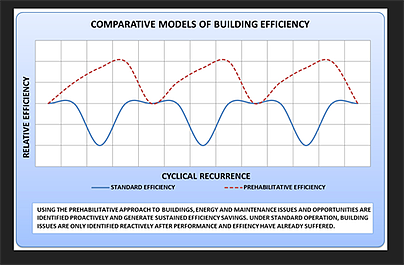Share this
Run Your Building Like an Athlete to Create Smart Buildings – Part 2
by Paul Campbell on Aug 14, 2018
This post is part of The Adaptive Energy Management Guide.
Become Data-Centric
When taking a prehabilitative approach, whether in buildings or in sports medicine, statistical analysis is the cornerstone for defining opportunities for performance improvement.
In sports medicine, being data centric requires collecting data on the risks of various athletic endeavors. What joints or muscles tend to deteriorate over time if not properly conditioned? How can those joints and muscles be monitored over time? What data sets are there to benchmark performance and gain insight into strengths and weaknesses?
For smart building operators, relevant data are those that impact the risks of the building underperforming. These data sources include energy usage, control system data, sensors, weather, schedules, occupancy, energy market data, and so on. Once you understand the data you should be analyzing (in other words, the data that impacts your energy consumption and costs), data can be interpreted in context to determine where opportunities for improvement lie. Or, from a statistical perspective, where outliers exist, enabling prioritization of opportunities for improvement.
Get Specific
Athletes utilize prehabilitation to target specific areas of the body. For example, a baseball pitcher might focus on strengthening muscles around the elbow, while a basketball player hones in on the knees and ankles.
For building operators, being targeted means recognizing that some systems will be functioning well and some not so well at any given time. However, knowing you have a problem (i.e. an outlier) is only the first step. Once you have utilized data analysis to identify outliers, it’s important to take the next step and deploy additional tools to ascertain why those outliers are having problem. At this stage, the concept of Fault Detection Diagnostics (FDD) comes into play.
Fault Detection Diagnostics (FDD) targets energy and mechanical issues, and though the concept has been prevalent in the building science world for time, it seems FDD is gaining ground in the mainstream. FDD tools sift through your various data sources and, instead of saying “this building is having an issue,” they say, “this air handler, or chiller, or rooftop unit is having an issue.” Furthermore, FDD tools not only pinpoint equipment issues, they also ideally tell you how much it’s costing you, simplifying the prioritization process.
In short, FDD tools provide crucial steps toward targeted, smarter decision-making relative to your energy budget. However, a “buyer beware” statement is in order. Be aware that some companies advertising FDD tools might glaze over the fact that extensive new sensor and hardware installation will be required for their tools to return results. This can translate to significant expense, as well as a slow return on investment. If you are considering FDD tools, hone in on those that utilize your existing infrastructure and data sources, and then add on as necessary once you’ve realized positive ROI.
Proactive Practices Replace Reactive Responses
Last but not least, prehabilitation is proactive. For an athlete, this means anticipating injuries rather than waiting for them to happen, as well as knowing that if the body is properly conditioned it can heal faster than if not.
For building operators, being proactive involves leveraging predictive analytics to facilitate smarter and faster decision-making. Predictive analytics tools utilize historical data to look for patterns, and then use forecasted data to determine how those historical patterns will shape future performance. Many companies are already using predictive analytics to find out about their customers’ behavior, the direction of the market, and so on. These same tools can help building operators run their buildings more intelligently.

For instance, utilizing predictive analytics, you might look at warm weather that is expected or high occupancy that is scheduled and preemptively pre-cool the building to offset the spike in demand. Or, you might use market pricing in conjunction with historical usage data to make better-informed forward and real time energy purchases. In essence, once you have an understanding of the past that is based on historical data, you are able to make well-informed predictions about the future. And, you’ll find it much easier to stay ahead of the curve than playing catch up.
The possibilities for applying prehabilitation methods to buildings are endless with a clear understanding and correct application. Whether you’re a building operator, energy manager or facility manager looking for ways to take the next step in reducing your energy and maintenance costs, take a hard look at one of your favorite athletes who’s at the top of their game and consider how their physical conditioning program can inspire you to condition your buildings for optimal performance, too.
Related Posts
What Facility Managers Need to Know About Load Shifting - Part 1
Adaptive Energy Management Guide
Are You Managing Your Energy Spend?
4 Common Myths of Energy Conservation in Building Management
Precision Building Management: Understanding Closed Loop Control
Share this
- Facilities Management (91)
- Energy Management (69)
- Company News (49)
- Smart Buildings (37)
- Retail (36)
- Building Management (24)
- Building Automation Systems (21)
- Sustainability (20)
- Energy Demand Management (19)
- EEI (15)
- Adaptive Energy Management (14)
- Grocery (14)
- demand response (14)
- Artificial Intelligence (12)
- Data Integration and Visibility (10)
- HVAC IQ (9)
- COVID-19 (8)
- Customer Spotlight (8)
- Carbon Management (7)
- Setpoints and Temperatures (7)
- Equipment Maintenance (6)
- Operational Efficiency (6)
- Refrigeration Optimization (6)
- Ask Ron (5)
- Asset Manager (5)
- Finance and Procurement (5)
- IoT and Digital Transformation (5)
- Awards (4)
- Comfort (4)
- Energy & Store Development (4)
- Safety and Compliance (4)
- Demand Charge Management (3)
- Energy Management System (3)
- Lifecycle Asset Management (3)
- Premium Services (3)
- Refrigeration IQ (3)
- Automated Demand Response (2)
- ConnexFM (2)
- Customer Service (2)
- HVAC Vendor Management (2)
- Load Shedding (2)
- Technician View (2)
- AIM Act (1)
- ALD (1)
- Analytics (1)
- Data (1)
- Data Integration and Visualization (1)
- EMS (1)
- Knowledge Center (1)
- OSHA (1)
- asset management (1)
- December 2025 (1)
- November 2025 (1)
- October 2025 (2)
- September 2025 (1)
- August 2025 (3)
- July 2025 (1)
- June 2025 (1)
- May 2025 (2)
- March 2025 (2)
- February 2025 (1)
- January 2025 (2)
- December 2024 (2)
- October 2024 (1)
- September 2024 (1)
- August 2024 (2)
- June 2024 (2)
- April 2024 (2)
- March 2024 (2)
- January 2024 (1)
- December 2023 (1)
- October 2023 (2)
- September 2023 (2)
- August 2023 (2)
- July 2023 (1)
- May 2023 (2)
- April 2023 (2)
- March 2023 (3)
- February 2023 (1)
- January 2023 (1)
- December 2022 (1)
- November 2022 (2)
- October 2022 (2)
- September 2022 (1)
- May 2022 (2)
- April 2022 (1)
- March 2022 (3)
- February 2022 (2)
- January 2022 (4)
- December 2021 (2)
- November 2021 (3)
- October 2021 (1)
- September 2021 (3)
- August 2021 (4)
- July 2021 (1)
- June 2021 (2)
- May 2021 (1)
- January 2021 (2)
- December 2020 (2)
- November 2020 (2)
- October 2020 (3)
- September 2020 (4)
- August 2020 (3)
- July 2020 (2)
- June 2020 (3)
- May 2020 (3)
- April 2020 (5)
- March 2020 (5)
- February 2020 (4)
- January 2020 (4)
- December 2019 (4)
- November 2019 (3)
- October 2019 (4)
- September 2019 (5)
- August 2019 (4)
- July 2019 (4)
- May 2019 (2)
- April 2019 (3)
- February 2019 (1)
- December 2018 (1)
- November 2018 (1)
- October 2018 (3)
- September 2018 (3)
- August 2018 (3)
- July 2018 (3)
- June 2018 (3)
- May 2018 (1)
- June 2015 (1)
- March 2013 (1)
- January 2013 (1)
- December 2011 (1)
- October 2011 (1)
- September 2011 (1)


